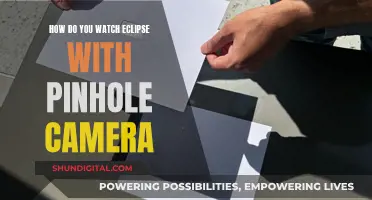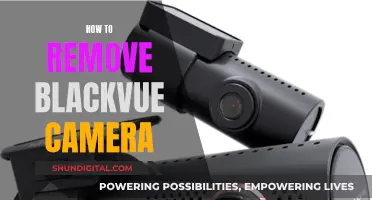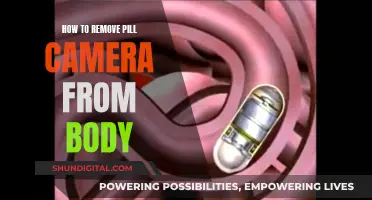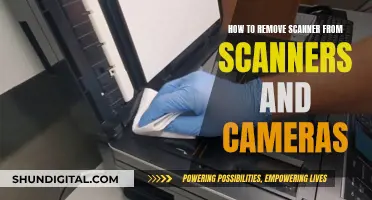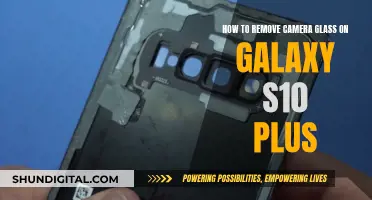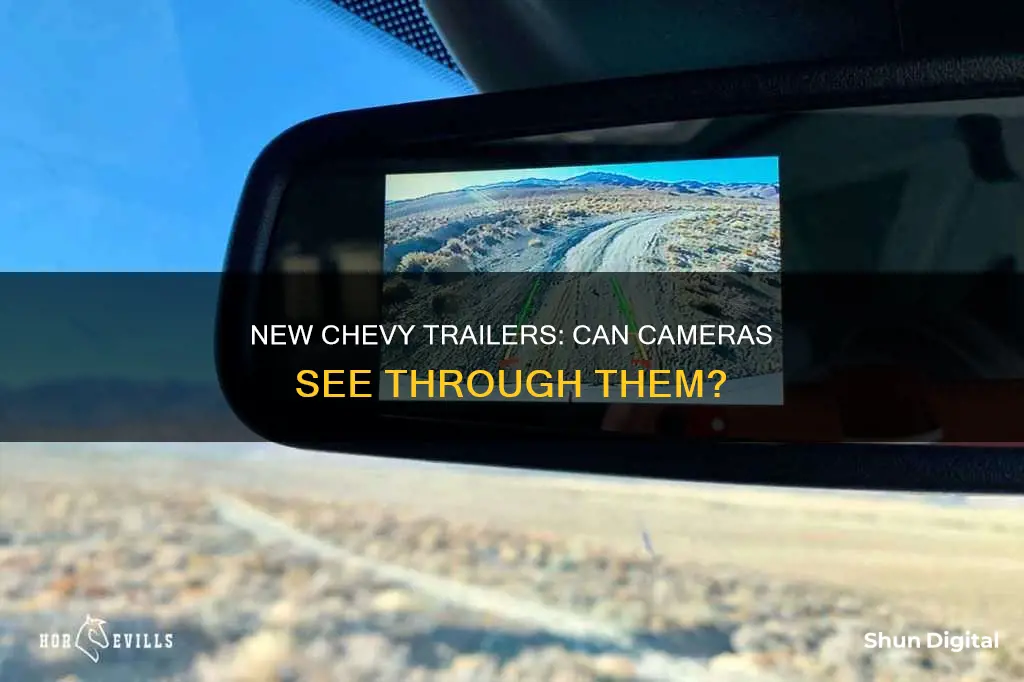
The latest in truck technology is the see-through trailer camera, which makes towing large trailers or vehicles safer and easier. This feature is available on certain trucks, including the 2020 Chevrolet Silverado. The see-through trailer camera, also known as the Chevy invisible trailer feature, uses multiple cameras and software algorithms to provide drivers with a clear view of their surroundings, including the area behind the trailer, which is usually obscured. This enhances visibility and situational awareness, making it easier to manoeuvre, park, or change lanes. The system combines footage from the various cameras to create a seamless composite view, giving the illusion that the trailer is invisible.
| Characteristics | Values |
|---|---|
| Name | Chevy Invisible Trailer Camera |
| Vehicle Types | Trucks, SUVs, and other models designed for towing |
| Camera Views | Up to 15 different viewpoints, 8 cameras, 14 views |
| Camera Types | Rearview, Front and Rear Underbody, Dual-function rearview mirror, Transparent Trailer View, Bird's Eye View, Hitch View, Driving View, Parking View, etc. |
| Camera Features | Image stitching, perspective correction, object detection, distance markers, trajectory lines, warning alerts |
| Camera Setup | Installation of an Auxiliary Accessory Trailer Camera on the exterior of the trailer, calibration of the camera system |
| Camera Activation | When the vehicle is in reverse gear or manually selected from the infotainment system |
| Display | Monitor or touchscreen interface inside the vehicle |
| Trailer Compatibility | Conventional hitch box-type trailer, no more than 32 feet in length |
What You'll Learn

How does the camera system work?
The Chevy Invisible Trailer Camera is an advanced technology that enhances visibility and safety while towing trailers, boats, or other large vehicles. It combines multiple cameras and software algorithms to provide drivers with a clear view of their surroundings, including the area behind the trailer, which is usually obscured. This system is designed to address the challenges of towing large trailers or vehicles, especially when navigating through traffic or manoeuvring in tight spaces.
The camera system consists of multiple high-definition cameras strategically positioned around the vehicle and trailer to capture a 360-degree view of the surroundings. These cameras are typically mounted on the rear and sides of the vehicle and the back of the trailer, providing comprehensive coverage of blind spots. The captured video footage is then fed to a central processing unit, which combines and processes the images to create a composite view of the vehicle and its surroundings. This composite view is then displayed on a monitor or touchscreen interface inside the vehicle's cabin, providing drivers with a real-time, comprehensive view of their surroundings.
The system's software algorithms play a crucial role in enhancing the video streams from the individual cameras. These algorithms perform tasks such as image stitching, perspective correction, and object detection to create a seamless and detailed composite view. Additionally, the software incorporates features such as distance markers, trajectory lines, and warning alerts to assist drivers in making informed decisions and executing manoeuvres with precision and confidence.
The Chevy Invisible Trailer Camera is typically activated when the vehicle is in reverse gear or when the driver manually selects the camera view from the infotainment system. Once activated, the system begins capturing live video footage, processing it in real-time, and creating a composite view for the driver. This real-time monitoring feature allows drivers to assess potential obstacles or hazards and make informed decisions about manoeuvring, parking, or reversing safely.
The setup process for the Chevy Invisible Trailer Camera is straightforward. It involves installing the accessory trailer camera on the back of the trailer, entering the trailer's dimensions into the vehicle's infotainment system or a mobile app, and then calibrating the system. The calibration process confirms the entered dimensions and creates an accurate view of what's behind the trailer. This is done by driving forward in a straight line while the system automatically calibrates and processes the camera feeds.
Exploring Camera Lenses: Capturing the Full 180-Degree View
You may want to see also

How does it make the trailer invisible?
The Chevy Invisible Trailer Camera is an advanced technology that enhances visibility and safety while towing trailers, boats, or other large vehicles. It does this by employing a combination of strategically placed cameras and software algorithms to provide drivers with a clear view of their surroundings, including the area behind the trailer, which is usually obscured from view.
The camera system consists of multiple high-definition cameras positioned around the vehicle and trailer to capture a 360-degree view of the surroundings. These cameras are typically mounted on the rear of the vehicle, the sides of the vehicle, and the back of the trailer, providing comprehensive coverage of blind spots. The system then combines and processes the images from these cameras to create a composite view of the vehicle and its surroundings. This composite view is displayed on a monitor or touchscreen interface inside the vehicle, providing a seamless and detailed representation of the driver's surroundings in real time.
The invisible trailer feature specifically works by stitching together the footage from the various cameras in a way that looks natural. This includes a camera placed on the back of the trailer, which is combined with the feed from the tailgate camera. By combining these two views, the system creates an image that makes the trailer appear invisible.
To set up the Transparent Trailer View, users need to install an accessory trailer camera in a specific area on the back of their trailer and enter the trailer's dimensions into their Trailer Profile. The system then calibrates itself by confirming these dimensions, creating an accurate view of what's behind the trailer.
Home Security: Watching Your Home from Another State
You may want to see also

What are the components of the camera system?
The Chevy Invisible Trailer Camera System is a multi-camera system that enhances visibility and safety while towing trailers, boats, or other large vehicles. It consists of multiple high-definition cameras, a display unit, and software algorithms that work together to provide drivers with a clear view of their surroundings, including the area directly behind the trailer.
Camera System
The camera system comprises multiple high-definition cameras strategically positioned around the vehicle and trailer to capture a 360-degree view of the surroundings. These cameras are typically mounted on the rear of the vehicle, the sides of the vehicle, and the back of the trailer, providing comprehensive coverage of blind spots and traditionally obscured areas.
Display Unit
The captured video footage from the camera system is displayed on a monitor or touchscreen interface inside the vehicle's cabin, allowing drivers to view the live feed in real time. This display unit provides visual guidance for safe and accurate maneuvering, parking, or reversing of the vehicle and trailer.
Software and Processing Capabilities
The camera system utilises advanced software algorithms and processing capabilities to combine and enhance the video streams from the individual cameras. These algorithms perform tasks such as image stitching, perspective correction, and object detection to create a seamless and detailed composite view of the vehicle and trailer's surroundings.
Additionally, the software incorporates features such as:
- Distance markers
- Trajectory lines
- Warning alerts
- Trailer Angle Indicator with Trailer Guidelines
- Cargo Bed Zoom and Bed Hitch Guidance
Q-See Cameras: SmartThings Compatibility Explored
You may want to see also

How do you set up the camera system?
To set up the Chevy Transparent Trailer View, you will need a properly equipped truck, a compatible trailer, and the right tools to install the accessory camera. Here is a step-by-step guide:
- Install the Accessory Trailer Camera: Mount the accessory trailer camera on the back of your trailer. The ideal position for the camera lens is horizontally centred on the back of the trailer, vertically 4 inches higher than the tailgate camera on the truck, and angled 35 degrees downward from the horizontal. Markings on the mounting unit can help you find this position. Then, secure the wiring harness on the trailer's exterior, following the camera installation instructions. Finally, connect the camera to the connector at the trailer hitch, linking it to the rear trailer camera port.
- Enter Trailer's Dimensions: Access the trailering icon on your truck's infotainment system home screen and enter your compatible trailer's exact dimensions into the Trailer Profile. You will be guided through entering seven required dimensions, including the centre of the coupler to the furthest rear point, the ground to the tallest point of the trailer, and the hitch receiver to the centre of the ball.
- Calibrate Transparent Trailer View: Ensure that your trailer is attached, your Trailer Profile is active, and simply drive forward in a straight line. Calibration will begin automatically, and you can monitor its progress by tapping the Camera app icon on your infotainment system home screen. A progress bar will be displayed, and you may need to drive for several minutes until the progress bar is complete. If you need to turn or speed up, the calibration will pause and then resume once you straighten out and slow down.
Once these steps are completed, your Chevy Transparent Trailer View will be active, and you won't need to recalibrate unless you change the trailer's dimensions.
Apple Watch Series 1: Camera Expectations Explained
You may want to see also

What are the limitations and challenges?
The Chevy Invisible Trailer Camera is a groundbreaking technology that enhances visibility and safety when towing large objects. However, it does come with certain limitations and challenges that users should be aware of.
One of the main limitations is compatibility. The Invisible Trailer feature is not compatible with all trailers and requires the use of a compatible conventional hitch box-type trailer no more than 32 feet in length. Additionally, the system requires the installation of an accessory camera on the trailer, which may be an additional cost for some users. The setup process can also be time-consuming, as it involves measuring and entering trailer dimensions, mounting the camera in the correct position, and calibrating the system.
Another challenge is the impact of environmental factors on visibility. Adverse weather conditions such as rain, fog, or snow can impair camera performance and reduce image clarity. Bright sunlight or glare can also cause reflections or wash out the image, hindering the driver's view. In such cases, drivers must remain vigilant and rely on other visual cues and mirrors.
Technical glitches or malfunctions are another potential limitation. As with any technology, the system may experience software bugs, hardware failures, or connectivity issues that disrupt its functionality. To mitigate this risk, drivers should perform regular system checks and maintenance and familiarize themselves with alternative towing techniques in case of camera failure.
Finally, there is a learning curve associated with the technology. While designed to be user-friendly, some drivers may need time to adjust to the system, interpret the visual aids, and integrate its features into their towing routine. This learning period can be overcome through the use of training materials and tutorials provided by Chevy, as well as practice in controlled environments.
Despite these limitations and challenges, the Chevy Invisible Trailer Camera offers significant benefits in terms of visibility and safety when towing large objects, making it a valuable tool for drivers.
Camera Eclipse Viewing: Is It Safe?
You may want to see also


